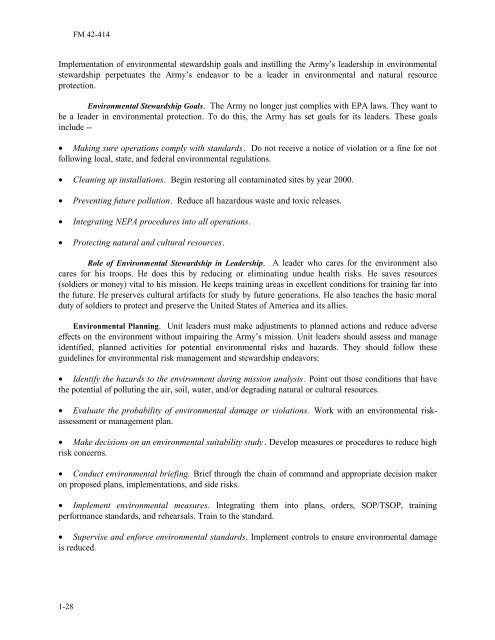Tactics, techniques, and procedures for - Army Electronic ...
Tactics, techniques, and procedures for - Army Electronic ...
Tactics, techniques, and procedures for - Army Electronic ...
You also want an ePaper? Increase the reach of your titles
YUMPU automatically turns print PDFs into web optimized ePapers that Google loves.
1-28<br />
FM 42-414<br />
Implementation of environmental stewardship goals <strong>and</strong> instilling the <strong>Army</strong>’s leadership in environmental<br />
stewardship perpetuates the <strong>Army</strong>’s endeavor to be a leader in environmental <strong>and</strong> natural resource<br />
protection.<br />
Environmental Stewardship Goals. The <strong>Army</strong> no longer just complies with EPA laws. They want to<br />
be a leader in environmental protection. To do this, the <strong>Army</strong> has set goals <strong>for</strong> its leaders. These goals<br />
include --<br />
• Making sure operations comply with st<strong>and</strong>ards. Do not receive a notice of violation or a fine <strong>for</strong> not<br />
following local, state, <strong>and</strong> federal environmental regulations.<br />
• Cleaning up installations. Begin restoring all contaminated sites by year 2000.<br />
• Preventing future pollution. Reduce all hazardous waste <strong>and</strong> toxic releases.<br />
• Integrating NEPA <strong>procedures</strong> into all operations.<br />
• Protecting natural <strong>and</strong> cultural resources.<br />
Role of Environmental Stewardship in Leadership. A leader who cares <strong>for</strong> the environment also<br />
cares <strong>for</strong> his troops. He does this by reducing or eliminating undue health risks. He saves resources<br />
(soldiers or money) vital to his mission. He keeps training areas in excellent conditions <strong>for</strong> training far into<br />
the future. He preserves cultural artifacts <strong>for</strong> study by future generations. He also teaches the basic moral<br />
duty of soldiers to protect <strong>and</strong> preserve the United States of America <strong>and</strong> its allies.<br />
Environmental Planning. Unit leaders must make adjustments to planned actions <strong>and</strong> reduce adverse<br />
effects on the environment without impairing the <strong>Army</strong>’s mission. Unit leaders should assess <strong>and</strong> manage<br />
identified, planned activities <strong>for</strong> potential environmental risks <strong>and</strong> hazards. They should follow these<br />
guidelines <strong>for</strong> environmental risk management <strong>and</strong> stewardship endeavors:<br />
• Identify the hazards to the environment during mission analysis. Point out those conditions that have<br />
the potential of polluting the air, soil, water, <strong>and</strong>/or degrading natural or cultural resources.<br />
• Evaluate the probability of environmental damage or violations. Work with an environmental riskassessment<br />
or management plan.<br />
• Make decisions on an environmental suitability study . Develop measures or <strong>procedures</strong> to reduce high<br />
risk concerns.<br />
• Conduct environmental briefing. Brief through the chain of comm<strong>and</strong> <strong>and</strong> appropriate decision maker<br />
on proposed plans, implementations, <strong>and</strong> side risks.<br />
• Implement environmental measures. Integrating them into plans, orders, SOP/TSOP, training<br />
per<strong>for</strong>mance st<strong>and</strong>ards, <strong>and</strong> rehearsals. Train to the st<strong>and</strong>ard.<br />
• Supervise <strong>and</strong> en<strong>for</strong>ce environmental st<strong>and</strong>ards. Implement controls to ensure environmental damage<br />
is reduced.

















